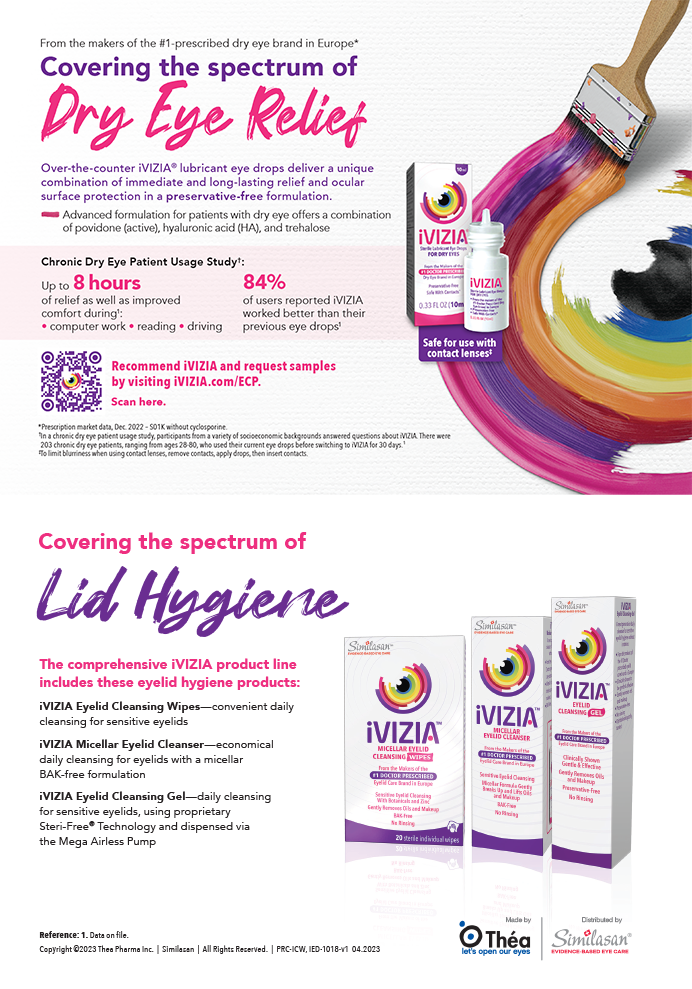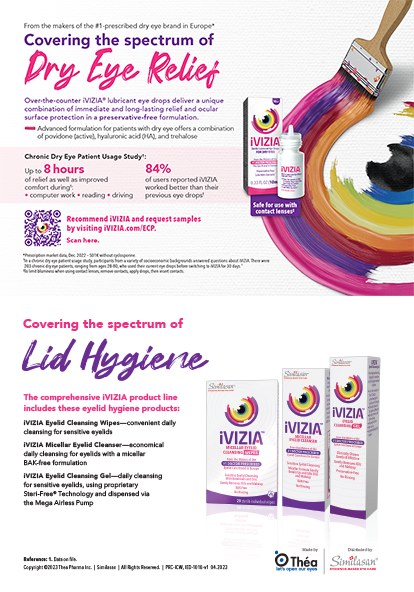Topical nonsteroidal anti-inflammatory drugs (NSAIDs) have become an important part of my perioperative regimen for cataract surgery. These agents not only reduce ocular discomfort and help dilate the pupil during surgery, but they also reportedly reduce the incidence of postoperative cystoid macular edema (CME).1,2
Preventing CME has become crucial to achieving optimal outcomes with multifocal IOLs. This article discusses my customary therapeutic regimen and why NSAIDs are important tools for reducing—or, ideally, preventing—the occurrence of CME after cataract surgery.
INCIDENCE OF CME
Until recently, physicians drew a distinction between angiographic and clinically significant CME.3 Angiographic CME is detected with fluorescein angiography, a procedure that is not routinely used to evaluate patients after cataract surgery. In contrast, cystic changes in the fovea accompanied by a decrease in visual acuity to 20/40 or worse are indicative of clinically significant CME. Based on these classifications, researchers have estimated that 12% of patients develop CME after routine cataract surgery.1
The incidence of CME is even higher among patients with preexisting retinal pathology (ie, diabetic retinopathy, epiretinal membrane, retinal vein occlusion). For example, as many as 50% of diabetic patients who do not have macular edema preoperatively develop this inflammatory condition after undergoing cataract surgery.4,5
We now know that CME occurs more frequently than we previously thought. Instead of relying on the presence of fluorescein leakage during angiography or significant changes in Snellen acuity to diagnose CME, we can detect very mild (or subclinical) cases of CME with optical coherence tomography. According to a few prospective studies, the incidence of CME defined by optical coherence tomography reportedly ranges from 4% to 10.9%.6,7
LONG-TERM EFFECTS OF CME
Clinicians have successfully treated CME with NSAIDs postoperatively,8,9 but studies have shown that patients whose visual acuity improves after using these drugs do not always regain the same level of retinal function that they had preoperatively.10 Even minimal retinal thickening associated with CME can decrease contrast sensitivity.11 I therefore use NSAIDs to prevent and, if necessary, treat CME in my patients (Figure 1).
MY PERIOPERATIVE REGIMEN
I recommend that any patient who undergoes cataract surgery use NSAIDs pre- and postoperatively. Prophylactic treatment is especially important for patients who receive premium IOLs, because they have higher expectations for excellent visual outcomes than those who receive monofocal IOLs. In particular, because multifocal IOLs may reduce contrast sensitivity, patients whose visual quality is further reduced by CME may be extremely dissatisfied with the results of their cataract surgery.
My patients with a low risk of developing CME typically start using NSAIDs 1 day before surgery and continue for at least 1 month postoperatively. High-risk patients (ie, anybody with preexisting macular or diabetic disease) start using NSAIDs 1 week before surgery and may use the drug for as long as 3 to 4 months postoperatively. My current NSAID of choice is nepafenac. All of my patients also use a corticosteroid postoperatively, because these agents work synergistically with NSAIDs to reduce ocular inflammation.4,12
The use of NSAIDs for preventing and treating CME is an off-label application.
Edward J. Holland, MD, is the director of cornea services at the Cincinnati Eye Institute and a professor of ophthalmology at the University of Cincinnati in Ohio. He is a consultant to Alcon Laboratories, Inc. Dr. Holland may be reached at (859) 331-9000 ext. 3064; eholland@fuse.net.
- McColgin AZ, Raizman MB. Efficacy of topical diclofenac in reducing the incidence of postoperative cystoid macular edema. Invest Ophthalmol Vis Sci. 1999;40:S289.
- Samiy N, Foster CS. The role of nonsteroidal anti-inflammatory drugs in ocular inflammation. Int Ophthalmol Clin. 1996;36(1):195-206.
- Heier JS, Topping TM, et al. Ketorolac versus prednisolone versus combination therapy in treatment of acute pseudophakic cystoid macular edema. Ophthalmology. 2000;107(11):2034-2039.
- Henderson BA, Kim JY, Ament CS, et al. Clinical pseudophakic cystoid macular edema. Risk factors for development and duration after treatment. J Cataract Refract Surg. 2007;33:1550-1558.
- Regillo CD, Brown GC, Flynn HW, eds. Vitreoretinal Disease. New York, NY: Thieme Publishers; 1999.
- Perente I, Utine CA, Cakir H, et al. Evaluation of macular changes after uncomplicated phacoemulsification surgery by optical coherence tomography. Curr Eye Res. 2007;32:241-247.
- Kim SJ, Bressler NM. Optical coherence tomography and cataract surgery. Curr Opin Ophthalmol. 2009;20:46-51.
- Jampol LM. Pharmacologic therapy of aphakic cystoid macular edema: a review. Ophthalmology. 1982;89:891-897.
- Jampol LM. Pharmacologic therapy of aphakic and pseudophakic cystoid macular edema: 1985 update. Ophthalmology. 1985;92:807-810.
- Nelson ML, Martidis A. Managing cystoid macular edema after cataract surgery. Curr Opin Ophthalmol. 2003;14:39-43.
- Ibanez HE, Lesher MP, Singerman LJ, et al. Prospective evaluation of the effect of pseudophakic cystoid macular edema on contrast sensitivity. Arch Ophthalmol. 1993;111(12):1635-1639.
- Almeida DRP, Johnson D, Hollands H, et al. Effect of prophylactic nonsteroidal anti-inflammatory drugs on cystoid macular edema assessed using optical coherence tomography quantification of total macular volume after cataract surgery. J Cataract Refract Surg. 2008;34:64-69.


